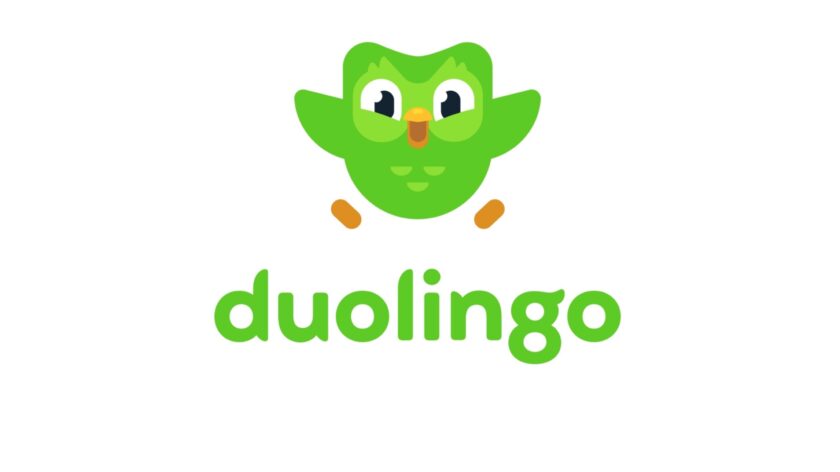Mid-year I got a reader question inviting me to review the DuoLingo language-learning application. Since then I have given a lot of thought as to how to present such a review and after almost a full year of daily use I feel prepared to do so. This article is an in-depth DuoLingo review.
Full disclosure: I don’t make a cent from DuoLingo. I have no affiliate relationship, financial relationship, other kind of relationship with DuoLingo. It benefits me in no what whatsoever if you download or purchase this app. This review was not coordinated with them in any way. In fact, they don’t know that I even exist. This in-depth review of DuoLingo is my honest, unvarnished opinion.
My History with DuoLingo
This isn’t my first time using the app. I used DuoLingo for a couple of months back in 2017. A friend got me into it and I stuck with it for a couple of months. Having no real, clearly-defined goal I gave it up once I broke my first decent streak. I deleted the app from my phone a few weeks later.
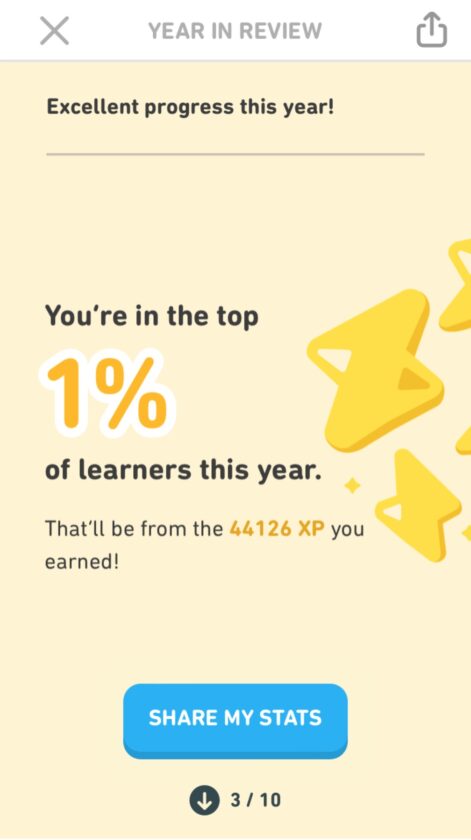
Last year (2020) I decided as a New Year’s resolution that I wanted to learn a second language. Being in paramedic school, working, and doing clinicals left little time for an in-person class, so I turned to what I knew – the DuoLingo app. I downloaded it with the goal of doing about 10 minutes a day of Spanish.
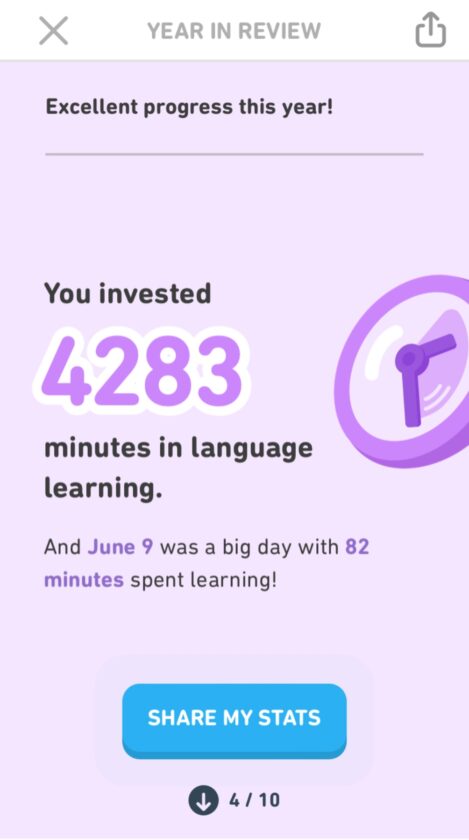
I did really, really well with that goal. Despite missing 15 days in 2021 I still averaged 11.75 minutes a day learning Spanish. In 2022 I plan to do it all again. Let’s talk about what that looks like.
Pro-Tip: Go Pro
If you’re serious about using the DuoLingo, spring for the pro version (it’s actually called “Plus”). Pay the $60 bucks for the Plus version of the software. At first I was like, “screw that – I’m going to get this information for free!” I very quickly recanted. The free version locks you out of lessons for several hours after a certain number of mistakes (3 or 5, I can’t remember). Since I sometimes make a lot of mistakes and want to spend a lot of time per day in the app this was unacceptable.
The other problem with the free version is advertisements. You are constantly presented with ads. You are sometimes offered amnesty on some of your mistakes if you’ll watch a 30-second commercial. I hate ads. The time I saved over a year is immeasurable.
If you’re going to get serious with DuoLingo, pay up and save yourself some time and frustration. My girlfriend is also a DuoLingo user (German) with an enviable 273-day streak at the time of this writing. She totally agrees that a paid subscription is the way to go.
My In-Depth DuoLingo Review
DuoLingo offers a number of different languages.By far the most popular is Spanish, but pretty much any commonly-spoken language is supported including French, German, Italian, Japanese, Chinese, Russian, Korean, Portuguese, Arabic, Dutch, Greek, Hindi… Some really uncommon languages are supported, too, like Irish, Navajo, and Esparanto. Believe it or not DuoLingo also offers a few fictional languages like Klingon and High Valyrian.
One quick note/disclaimer: one reason I took so long to write an in-depth DuoLingo review is that the app is constantly changing. DuoLingo seems to do a lot of “live testing,” tweaking minor things in the app. The placement of icons, the format of mistake review, points awarded for certain accomplishments all seem to be in flux from week-to-week. The core functionality of the app doesn’t really change, however.
Instructional Flow
I can’t speak for every language, but I believe most are similar. The app starts with lessons grouped into categories like Intro, Phrases, Travel, Restaurants, and Family. It seems as though the app attempts to start with some functional stuff right out of the gate. Each category consists of five “crowns” that you can win, each by completing five sub-lessons.
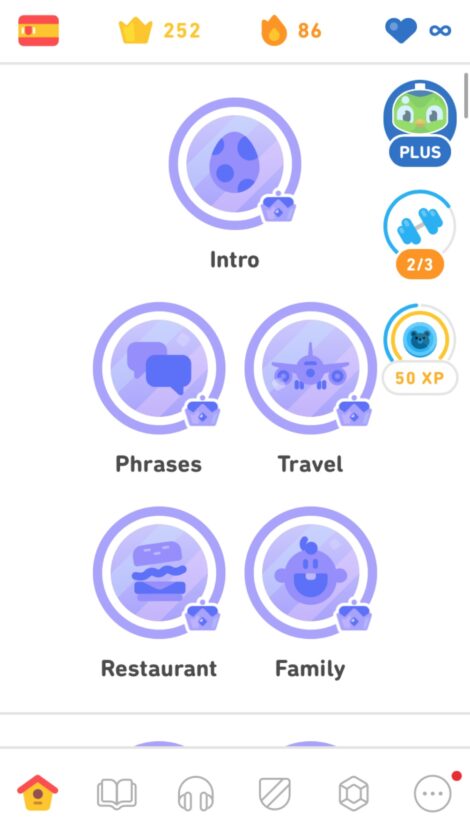
Each sub-lesson consists of about 20 questions. These sub-lessons are the core of the DuoLingo experience. Completing a single lesson generally takes around five minutes, which makes each lesson seem pretty manageable.
Winning all five “crowns” closes out that category, with an option sixth crown that tests you at a harder level. You’ll notice some of my categories (like the ones above) are purple, but most are yellow. The purple categories are the ones for which I completed the sixth crown.
Types of Exercises
DuoLingo uses three basic types of instructional exercises: written exercises, listening exercises, and speaking exercises.
Written Exercises
Written exercises are presented in several different ways. Sometimes you are presented with a sentence in Spanish and asked to write it out in English, or vice-versa.
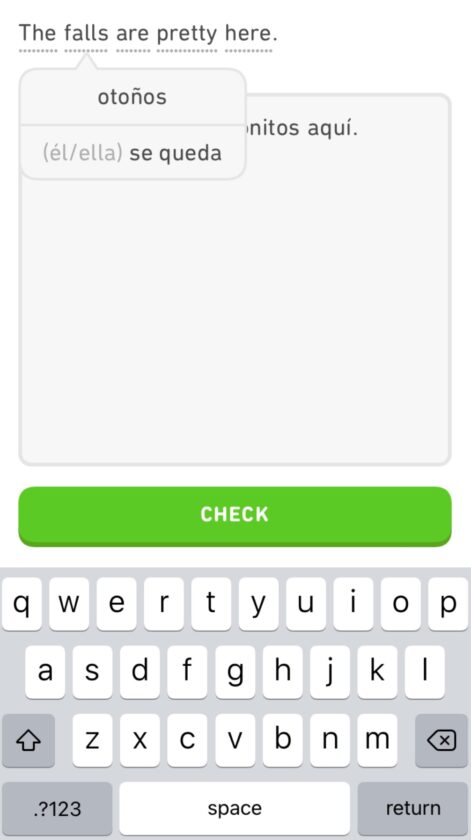
Sometimes you will be presented with a Spanish sentence with a blank or two, and asked to fill into the blank. Occasionally, you will be shown a word or phrase (like “The passport”) and asked to translate it to Spanish. Written exercises comprise the bulk of DuoLingo lessons.
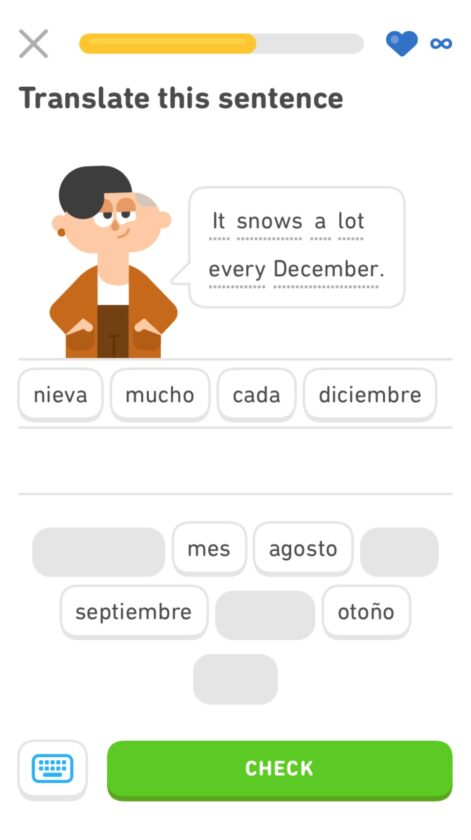
Written exercises are the easiest to do in public, at work, whatever. Though the app will speak each sentence out loud, you can turn your volume down. I would generally recommend against this – hearing the language spoken is important to learning it – but if you’re in the waiting room at the doctor’s office you may not want DuoLingo broadcasting that “Yo como manzanas!”
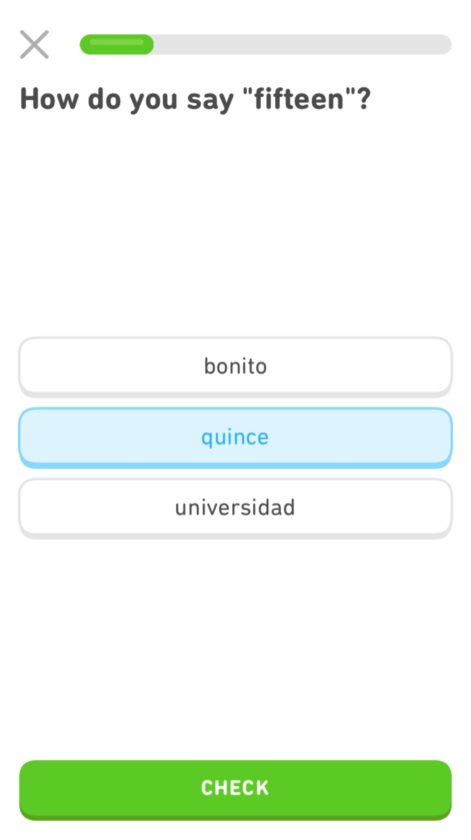
Listening Exercises
DuoLingo also provides listening exercises. These require that your volume is at least audible to hear and translate the spoken sentence. These come in a couple forms, but the most common is a spoken sentence in Spanish which you are then expected type out.
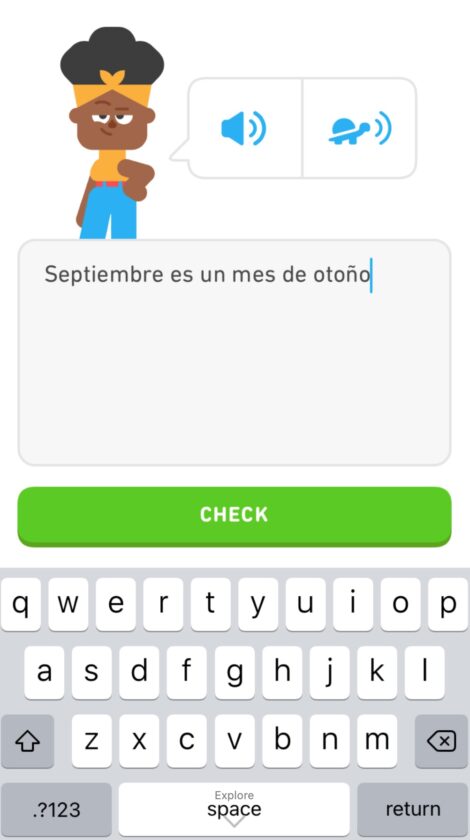
To be honest, these are my least favorite because of some of the voices on the app. The app tries to present a variety of voices, male and female, slow and fast, deep and high. Some are very annoying. If you can’t listen to the app when you have time to practice you can tap the “can’t listen now” button which turns listening exercises off for an hour. Alternatively, you can completely disable them in your settings.
Speaking Exercises
Speaking exercises are presented so you get some encouragement to actually speak the language. I admit that without these exercises I would rarely speak the lessons aloud, as I should. I have a love/hate relationship with the speaking exercises, however.
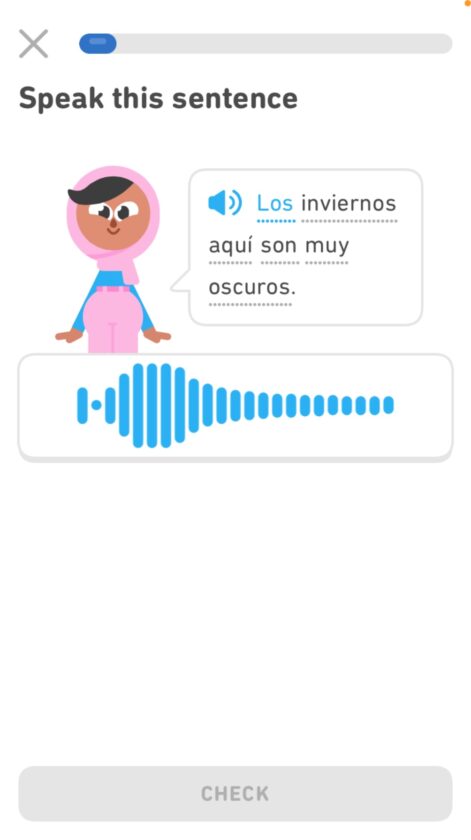
My problem with the speaking exercises is that sometimes, no matter what, I cannot pass them. Even after enunciating the sentence with the utmost precision I can muster, the app will still tell me I’m wrong. At other times I can grunt almost anything and the app will issue a “Correct!” This inconsistency is supremely frustrating.
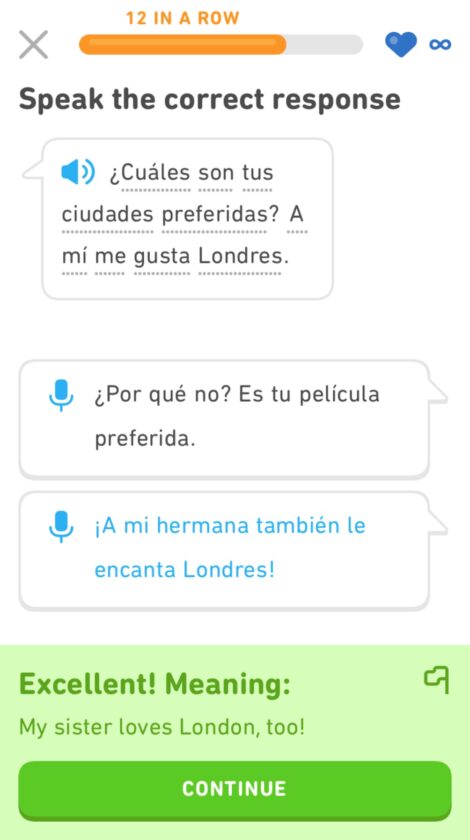
I try to deal with it because of the importance of actually speaking the language. Like listening exercises, speaking exercises can be turned off temporarily for 1 hour, or permanently in your profile settings.
Review Questions
One thing that can be frustrating or satisfying (depending on your point of view) is DuoLingo’s insistence that you review. Once you win all five (or six) crowns in a category and close that category out, you’re done, right? Not so fast…every now and then that category will become stale, as illustrated by a cracked appearance.
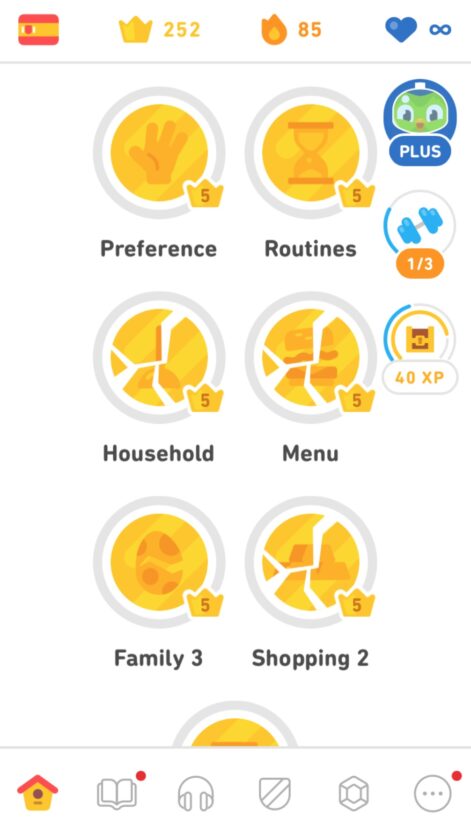
This means that you haven’t practiced this category in a while. As you can see in the screenshot above, I haven’t practiced Household, Menu, or Shopping 2 skills in a couple of weeks, and need to refresh them.
Practice sessions are 20 questions long. I generally find them to be a little easier than new lessons because I’ve covered the material before, and they usually go pretty fast. More importantly, I have found that they really help me reinforce some words and concepts that I’ve had difficulty with.
DuoLingo Gamification
No in-depth review of DuoLingo would be complete without mentioning gamification. This app is rife with features that give it a game-like feel and encourage you to spend more time. With most things this would feel manipulative to me (a huge reason I don’t have Facebook, Insta, or TikTok) but since spending more time in the app is my goal I don’t mind. I sort of embraced it.
The Leaderboard
First, there is a leaderboard that resets every Sunday. There are ten leagues (Bronze through Diamond) that you can advance through. You advance by staying in your current league for the week and maintaining enough points (earned through doing lessons) that you stay in the top 10 people in the league. If you’re in the top 10 on Sunday night you advance up on Monday morning.
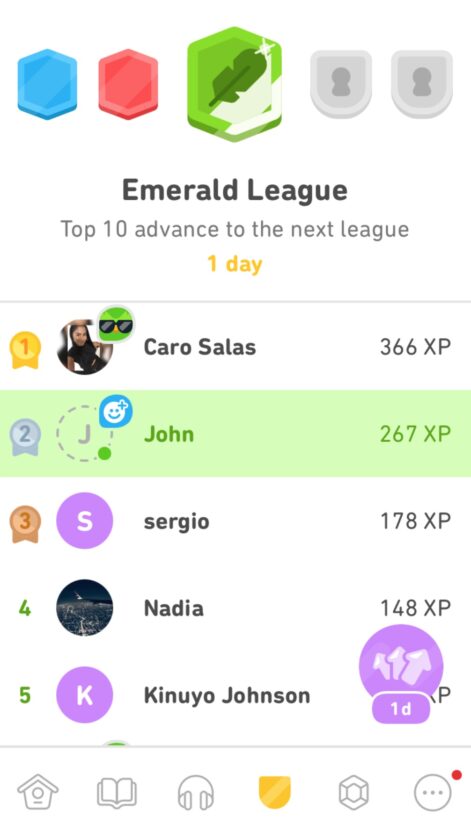
I will admit that the leaderboard got to me and kept me in the app for much longer than I otherwise would have stayed. I’m proud to say that I spent over half the year (173 days) in the Diamond league. That sounds a little silly, even to my ears, but I worked my ass off to get there and stay there, and learned more Spanish because of it.
The Streak
Next, DuoLingo keeps track of your daily streak – the number of days in a row you’ve studied. The streak is an extremely simple, yet powerful tool. When I had a really good streak going I would work very hard not to break it. Once I broke my streak it was hard to stay back on the horse – simple as that.

One thing I don’t like at all is the “streak freeze” – a feature that keeps your streak in place if you miss a day. Sometimes these are awarded automatically, and automatically applied when you miss a day. While it superficially feels good to keep your streak in place, it doesn’t feel genuine. Currently I have an 86-day streak…yet I know I’ve missed a couple days in there. I’d like to know what my actual streak is.
Other Gamification Stuff
Next, there is a recurring monthly goal to do at least 1,000 XP per calendar month. “XP” are points earned for doing lessons. The average lesson is worth about 15 XP…but it’s easier to rack up points than that makes it sound.
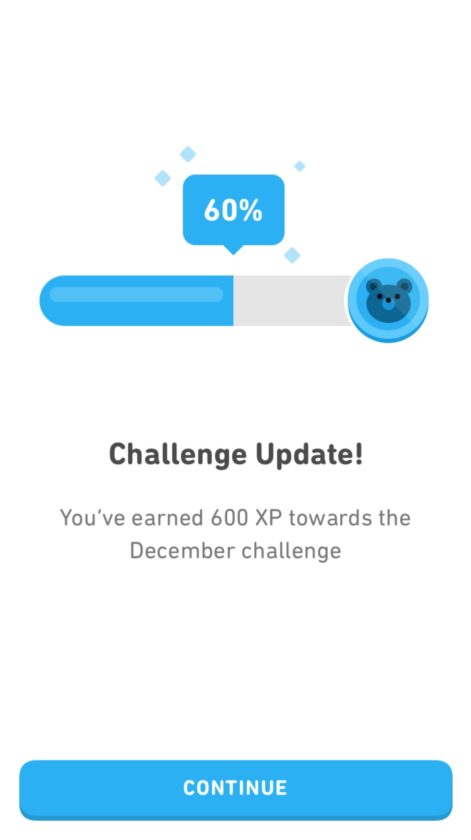
Every time you close a set of five lessons and earn a crown, you also get 15 minutes of double points. These can add up super fast. Some lessons are also worth much more; the lessons in the purple, sixth crown in each set are worth 40 XP each. Combined with a double-point session you can see how these could add up to huge numbers. If you’re willing to invest half an hour a day you can produce some huge numbers.
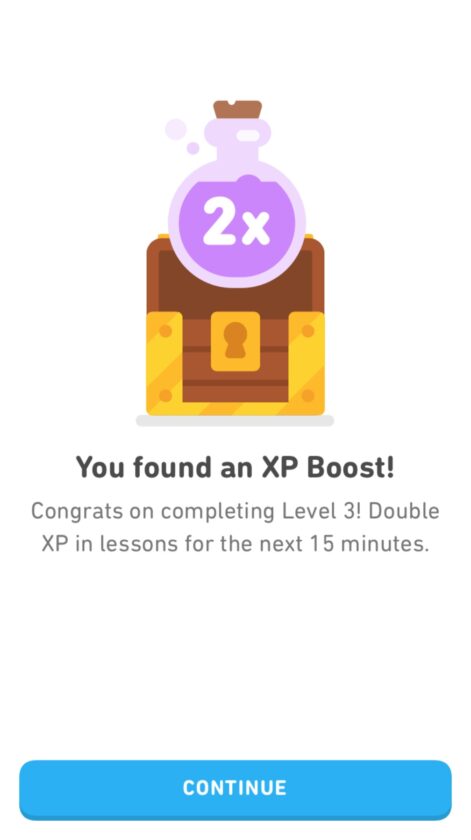
DuoLingo also makes it easy to share achievements via social media. If, like me, you don’t have social media, you can connect directly with other users of the app and “high five” them for their achievements.
One other thing that some find frustrating is the awarding of gems. Your XP are converted into gems that accumulate pretty rapidly. Gems can be used to purchase certain perks like streak freezes, but they are pretty limited. There’s just not much you can do with them. I have something over 12,000 gems and it would be nice to be able to spend them on something useful.
My Results With DuoLingo
An important aspect of an in-depth review of DuoLingo would be to mention my results.
The Good
First, I have learned a great deal of Spanish in the past year. I am constantly catching myself recognizing Spanish words on signs, from the radio, from conversations I pass on the street. The other day at the hospital while waiting to register a patient I caught myself reading a Spanish-language brochure…and was shocked at how much I understood. My reading and listening are pretty decent.
The Bad
Unfortunately I’m not great at speaking. I think this is because of a lack of practice. I very rarely challenge myself to actually go through the exercise of putting sentences together and speaking them. This is made even worse by the fact that I often study at work and turn speaking exercises off. Even if I left them on, I’m still only parroting what the app tells me to say.
To really learn a language you need to practice speaking. And not just making the sounds, but constructing the sentences, recalling the words, conjugating, all that stuff.
The Truth
Still, let’s keep this in context. For the very minor investment in my time – a few minutes a day spread over a year – I learned a TON. I wasn’t in class for an hour and a half each day. I was on an app, on my phone, for 10-15 minutes. It might seem like a big investment but it really wasn’t. For such a small effort I got a huge payback!
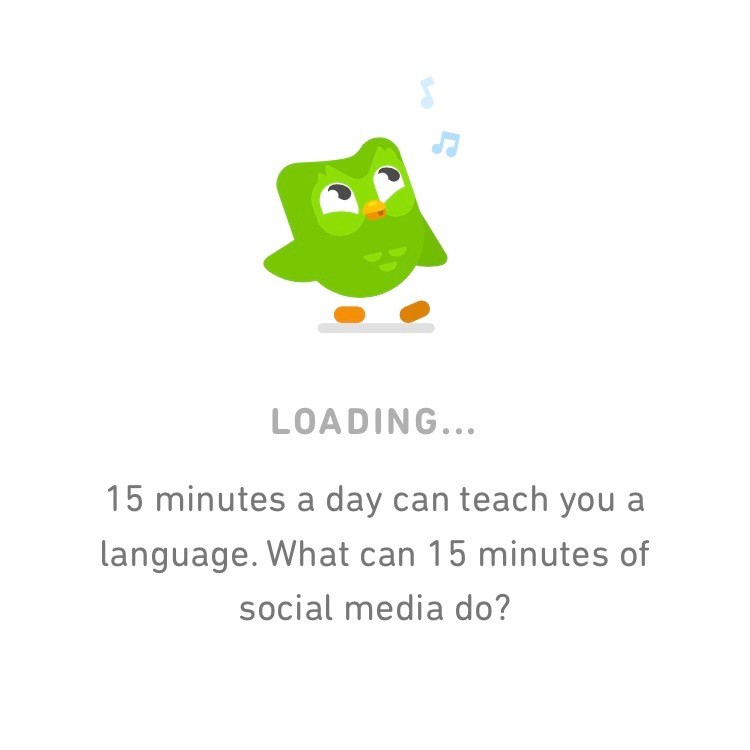
This investment has benefited me in the real world. In the past couple of months I have had two patients who spoke zero English. Though I wasn’t able to carry on a conversation I was able to gather basic information about their illness, biographical data, and provide them some comfort. That’s a pretty legit result in my book.
The Bottom Line
It may sound as if I have nothing bad to say about DuoLingo. And the truth is, I really don’t. In writing this in-depth review of DuoLingo I realized just how big a fan of this app I am. Though it can be a bit frustrating at times (some of the voices are very annoying) I really don’t have a bad thing to say about it.
Fifteen minutes a day isn’t much. I can go a long, long way toward making you better, smarter, more versatile. You can choose to spend it screwing around on social media deepening your negative emotions, or you can choose to spend it bettering yourself. I know what I choose.
